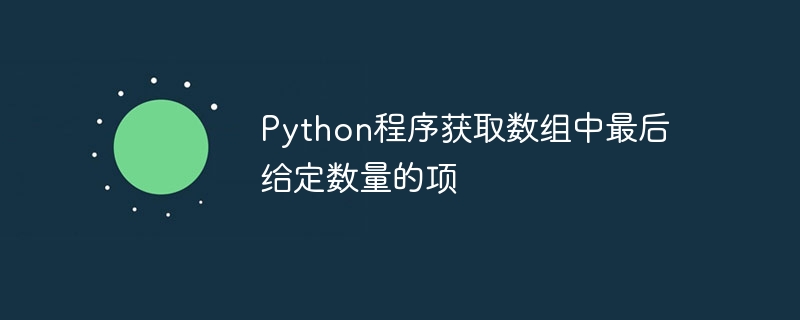Python程式取得數組中最後給定數量的項
- 王林轉載
- 2023-09-03 12:29:16737瀏覽

陣列是由許多具有相同資料類型的元素組成的資料結構,每個元素都由索引標識。
[2, 4, 0, 5, 8]
Python中的陣列
Python沒有自己的資料結構來表示陣列。然而,我們可以使用列表資料結構作為數組的替代方案。在這裡,我們將使用列表作為陣列:
[10, 4, 11, 76, 99]
python 提供了一些模組來更合適地處理數組,它們是 Numpy 和數組模組。
在本文中,我們將看到從陣列中存取最後給定數量的元素的不同方法。
輸入輸出場景
假設我們有一個包含 9 個整數值的輸入陣列。在輸出中,最後幾項是根據指定的數字進行存取的。
Input array: [1, 2, 3, 4, 5, 6, 7, 8, 9] Output: [7,8,9]
從輸入陣列存取最後 3 項 7、8、9。
Input array: [10, 21, 54, 29, 2, 8, 1] Output: [29, 2, 8, 1]
從輸入陣列中檢索最後 4 項。
在下面的範例中,我們將主要使用Python的負索引和切片功能來檢索最後幾個元素。
Python 中的負索引
Python 也支援負索引,即從陣列結尾開始用負號計數元素,並且從 1 開始,而不是從 0 開始。
[1, 2, 3, 4, 5] -5 -4 -3 -2 -1
第一個元素由索引值 –n 標識,最後一個元素為 -1。
在Python中的切片
使用Python中的切片功能,可以透過最短的語法從序列中存取一組元素。
文法
sequence_object[start : end : step]
開始:切片的起始索引,可迭代物件的切片起始位置,預設為0。
End:切片清單停止的結束索引。預設值為可迭代物件的長度。並且該值被排除在外。
使用列表
透過使用清單切片功能,我們可以存取陣列中最後給定數量的元素。
範例
讓我們舉個例子,應用清單切片來存取陣列中的最後幾個元素。
# creating array
lst = [1, 2, 0, 4, 2, 3, 8]
print ("The original array is: ", lst)
print()
numOfItems = 4
# Get last number of elements
result = lst[-numOfItems:]
print ("The last {} number of elements are: {}".format(numOfItems, result))
輸出
The original array is: [1, 2, 0, 4, 2, 3, 8] The last 4 number of elements are: [4, 2, 3, 8]
使用負索引從給定陣列中存取最後 4 個元素。
使用 NumPy 陣列
讓我們使用NumPy數組來存取最後給定數量的元素。
範例
在此範例中,我們將藉助負索引值存取 numpy 陣列元素。
import numpy
# creating array
numpy_array = numpy.random.randint(1, 10, 5)
print ("The original array is: ", numpy_array)
print()
numOfItems = 2
# get the last element
result = numpy_array[-numOfItems:]
print ("The last {} number of elements are: {}".format(numOfItems, result))
輸出
The original array is: [4 6 9 7 5] The last 2 number of elements are: [7 5]
我們已成功存取 NumPy 陣列中的最後 2 個元素。元素 7 使用 -2 進行索引,元素 5 使用 -1 進行索引。
使用陣列模組
透過使用array()方法,我們將建立一個特定資料類型的陣列。
範例
在此範例中,我們將使用 array 模組建立一個陣列。
import array
# creating array
arr = array.array('i', [6, 5, 8, 7])
print ("The original array is: ", arr)
print()
numOfItems = 2
# remove last elements
result = arr[-numOfItems:]
print ("The last {} number of elements are: {}".format(numOfItems, result))
輸出
The original array is: array('i', [6, 5, 8, 7])
The last 2 number of elements are: array('i', [8, 7])
從上面的範例中,已成功存取請求的項目數。如果請求的元素數量超過序列中的元素總數,Python 切片不會產生任何錯誤。
以上是Python程式取得數組中最後給定數量的項的詳細內容。更多資訊請關注PHP中文網其他相關文章!

